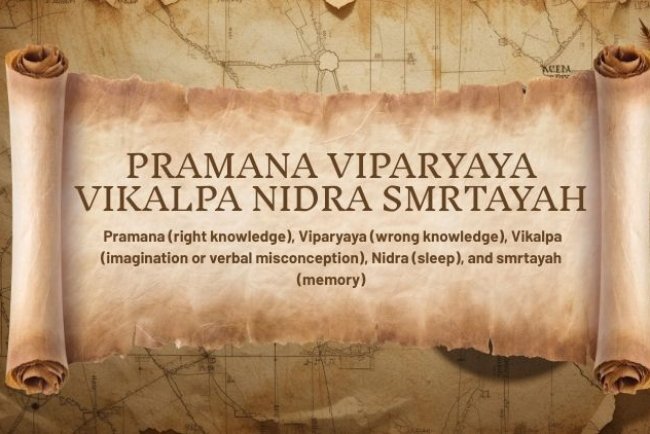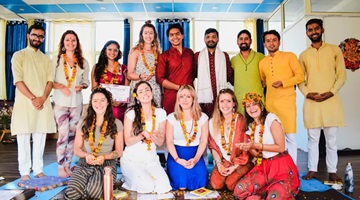Yoga Sutra 1.7 : Pratyaksa Anumana Agamah Pramanani

What is genuine truth?
Is everything you believe actually true?
In today’s world, overflowing with information, opinions, and half-truths, it’s easy to confuse noise with knowledge. Patanjali’s Yoga Sutra 1.7 – pratyaksa anumana agamah pramanani – acts like a mental filter, helping us sift through tangled thoughts and uncover only the clear, genuine truths.
This ancient sutra introduces three timeless ways of knowing—wisdom that is just as relevant now as it was thousands of years ago. Whether you’re making an important life decision or deepening your yoga practice, these principles guide you in separating fact from fiction, clarity from confusion.
-
Pratyaksa (Direct Experience): What you perceive through your own senses and awareness.
-
Anumana (Logical Inference): The reasoning that helps connect observations and draw conclusions.
-
Agama (Authoritative Testimony): Trustworthy knowledge passed down through teachers, texts, and lived tradition.
Together, these three form the foundation of reliable understanding. They sharpen not only your perception on the yoga mat, but also your discernment in everyday life.
Translation of Yoga Sutra 1.7: Pratyakṣa-anumāna-āgamāḥ pramāṇāni
प्रत्यक्षानुमानाअगमाः प्रमाणानि
pratyaksa-anumana-agamah pramanani
Translation:
“Direct perception, logical inference, and authoritative testimony are the means of valid knowledge.”
Breaking Down the Sutra
-
Pratyaksa (Direct Perception): Knowledge gained through direct observation or experience.
Example: You know the sun rises in the east because you have seen it yourself. This is Pratyakṣa Pramāṇa—truth verified by being a direct witness.
-
Anumana (Inference / Logical Reasoning): Knowledge derived through reasoning when direct perception is absent.
Example: You step outside in the morning and see wet ground. You did not see the rain, but you infer that it rained overnight. This is Anumāna Pramāṇa—truth reached through logical deduction. -
Agama (Scriptural or Authoritative Testimony): Knowledge received from trusted sources such as scriptures, enlightened teachers, or authentic traditions.
Example: Concepts like rebirth, Brahman, or Ātman are beyond ordinary perception or reasoning, yet they are conveyed through scriptures and considered valid within yogic philosophy. In Patanjali’s time, scriptures were regarded as the highest form of testimony; today, it can also extend to reliable sources of wisdom and lived traditions.
The Three Pramanas
1. Direct Perception (Pratyakṣa)
Knowledge derived directly through the senses—what you see, hear, smell, taste, or touch—is called pratyakṣa or direct perception. In yoga, this is heightened by conscious awareness. For example, during meditation you may notice stiffness in your shoulders. This recognition does not come from someone else telling you—it arises from your own lived experience. Patanjali values this form of knowledge because it is immediate and authentic, yet he reminds us that awareness is essential. Without clarity, even direct perception can be misinterpreted.
2. Inference (Anumāna)
Anumana is knowledge obtained through logical reasoning based on observed facts. For instance, even if you don’t see a fire, you may infer its presence if you smell smoke or feel heat. In yogic philosophy, inference helps fill in the gaps where direct perception is limited. It allows the intellect to connect observations, apply prior knowledge, and arrive at understanding. However, Patanjali cautions that inference must rest on sound reasoning. When built on faulty assumptions, it can lead to false conclusions.
3. Scriptural Testimony (Āgama or Śabda)
Agama, or scriptural testimony, refers to knowledge received from reliable and authoritative sources—sacred texts, enlightened teachers, or wisdom passed down through authentic lineages. This form of knowledge holds special value in yoga because it conveys truths beyond ordinary perception, such as the nature of the soul (atman) or liberation (mokṣa). Since not all realities can be verified by logic or personal experience alone, Patañjali includes authoritative testimony as a valid pramāṇa. Trusting the insight of those who have walked the path before us becomes a bridge to deeper understanding.
Living the Wisdom of Yoga Sutra 1.7
Patanjali’s Yoga Sutra 1.7 offers a simple yet powerful model for discerning truth: direct perception (pratyaksa), logical inference (anumāna), and reliable testimony (agama). This threefold path is not just philosophical—it can shape how we think, act, and grow in daily life.
1. Mindful Decision-Making
Life often pushes us to react quickly, but pratyakṣa reminds us to pause and observe what is truly present.
Example: Instead of jumping to conclusions at work or reacting to a rumor, we can stop, verify the facts ourselves, and respond with clarity rather than assumption.
2. Developing Critical Thinking
Anumana trains us to connect the dots with care and reason.
Example: If you notice headaches after long hours at your desk, logical inference may reveal that poor posture is the cause. Adjusting your workspace then becomes an act of mindfulness and self-care.
3. Seeking Trusted Guidance
Some truths cannot be discovered through perception or logic alone. Here, āgama encourages us to lean on trusted sources—sacred scriptures, authentic teachers, or wise mentors whose insight we respect. In yoga especially, this guidance shields us from misinformation and potential harm.
4. Enhancing Yoga Practice
These three approaches are not isolated; they complement one another. By weaving together direct experience, logical analysis, and trusted wisdom, your yoga practice becomes more integrated, discerning, and transformative.
5. Refuting False Assumptions
When applied together, pratyaksa, anumana, and agama act as a filter that strengthens discernment. They help us cross-check information, reducing the risk of falling prey to half-truths, misconceptions, or illusions.
In essence, Yoga Sutra 1.7 is not just about philosophy—it’s about cultivating a clear, reliable way of seeing the world, one that leads us closer to truth, both on and off the mat.
Find the Link to Deeper Practice
Pramana—right knowledge—is not just a mental exercise; it is the foundation for moving deeper into yoga’s essence. By learning to distinguish truth from misconception, you naturally begin to recognize viparyaya (distortions of the mind) as described in Yoga Sūtra 1.6. With this awareness, perception becomes clearer, the mind steadier, and your reactions more balanced.
Set the Right Foundation in Your Yogic Journey
If you are ready to establish a strong foundation in yoga and immerse yourself in the authentic teachings of Patañjali’s Yoga Sūtras, join us at Rishikesh Yogkulam. Step into the divine yogic realm and begin your journey toward clarity, balance, and transformation today.
What's Your Reaction?


























